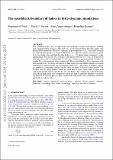The splashback boundary of haloes in hydrodynamic simulations
Author(s)
O’Neil, Stephanie; Barnes, David J; Vogelsberger, Mark; Diemer, Benedikt
DownloadAccepted version (2.650Mb)
Open Access Policy
Open Access Policy
Creative Commons Attribution-Noncommercial-Share Alike
Terms of use
Metadata
Show full item recordAbstract
ABSTRACT
The splashback radius, Rsp, is a physically motivated halo boundary that separates infalling and collapsed matter of haloes. We study Rsp in the hydrodynamic and dark matter-only IllustrisTNG simulations. The most commonly adopted signature of Rsp is the radius at which the radial density profiles are steepest. Therefore, we explicitly optimize our density profile fit to the profile slope and find that this leads to a $\sim 5{{\ \rm per\ cent}}$ larger radius compared to other optimizations. We calculate Rsp for haloes with masses between 1013 and 15 M⊙ as a function of halo mass, accretion rate, and redshift. Rsp decreases with mass and with redshift for haloes of similar M200 m in agreement with previous work. We also find that Rsp/R200 m decreases with halo accretion rate. We apply our analysis to dark matter, gas, and satellite galaxies associated with haloes to investigate the observational potential of Rsp. The radius of steepest slope in gas profiles is consistently smaller than the value calculated from dark matter profiles. The steepest slope in galaxy profiles, which are often used in observations, tends to agree with dark matter profiles but is lower for less massive haloes. We compare Rsp in hydrodynamic and N-body dark matter-only simulations and do not find a significant difference caused by the addition of baryonic physics. Thus, results from dark matter-only simulations should be applicable to realistic haloes.
Date issued
2021Department
Massachusetts Institute of Technology. Department of Physics; MIT Kavli Institute for Astrophysics and Space ResearchJournal
Monthly Notices of the Royal Astronomical Society
Publisher
Oxford University Press (OUP)
Citation
O’Neil, Stephanie, Barnes, David J, Vogelsberger, Mark and Diemer, Benedikt. 2021. "The splashback boundary of haloes in hydrodynamic simulations." Monthly Notices of the Royal Astronomical Society, 504 (3).
Version: Author's final manuscript